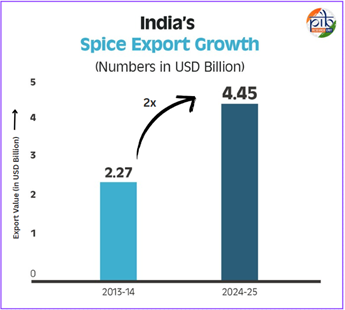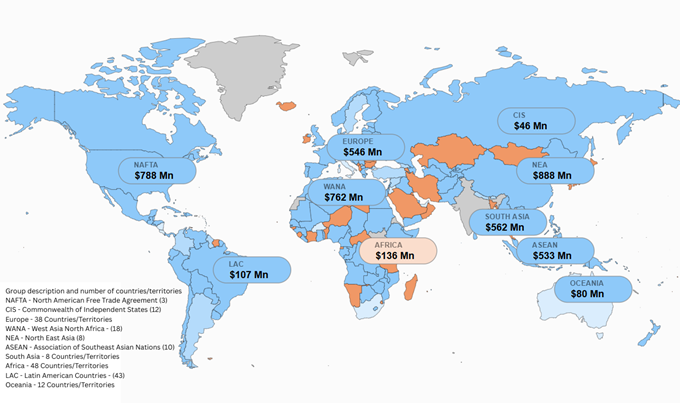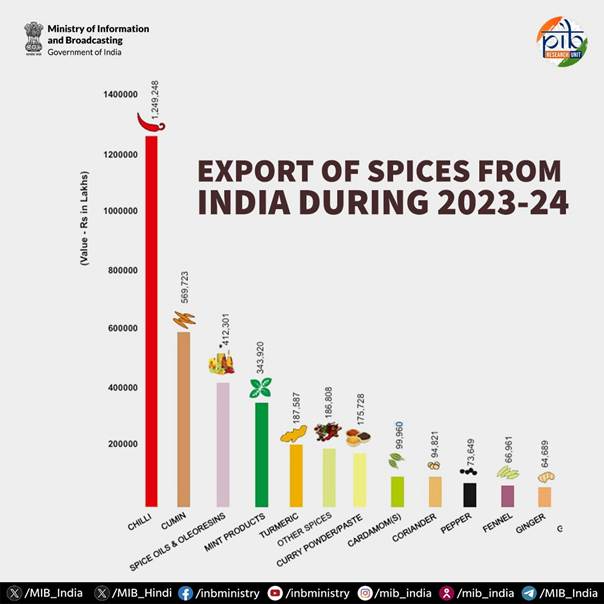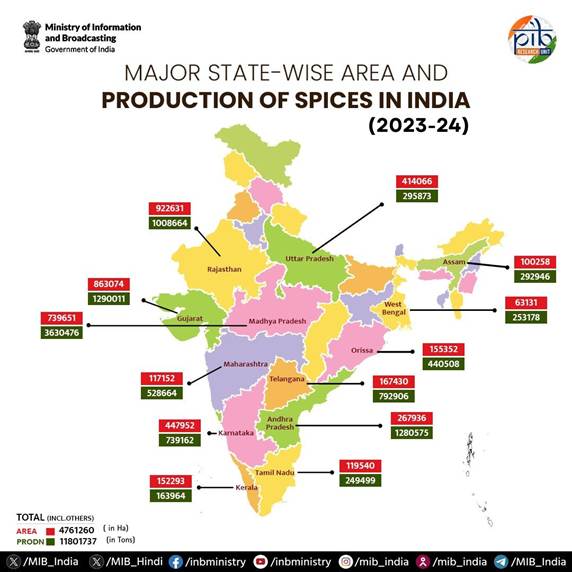Industries
Trading Aromas: The Rise of the Spice Economy
Posted On:
01 MAY 2025 4:03PM
Introduction
India, known as the ‘Land of Spices’, is the world’s largest producer, consumer, and exporter of spices. Of the 109 spices recognized by the International Organization for Standardization (ISO), India cultivates over 60 varieties. The spice sector contributes approximately 9% to India's total agricultural exports and over 40% of horticultural exports. With a global footprint spanning over 200 countries, India exports 225+ unique spice products, reinforcing its position as a trusted global supplier of both raw and value-added spices. Historically valued for their medicinal properties, spices remain integral to both Indian heritage and global health-conscious markets.
Exports Trends

India is the largest exporter of spice and spice items. It retained its position as the leading global exporter, with exports reaching USD 4.45 billion in FY 2024–25. Between 2013–14 and 2024–25, spice exports increased by 88% in volume, and 97% in value (USD)—reflecting India’s expanding presence in the global spice market. Gujarat led with 23.53% of total exports, followed by Kerala and Andhra Pradesh. In comparison, during 2013–14, spice exports stood at 817,250 MT, valued at USD 2,267.67 million showcasing a significant growth trajectory over the years.
Major Export Destinations
India exported spices and spice products to 200 destinations worldwide as of FY25 (up to December 2024). The top 10 destinations—China, USA, UAE, Bangladesh, Thailand, Malaysia, UK, Saudi Arabia, Indonesia, and Germany—collectively accounted for over 60% of total export earnings in FY25 (until February 2025).
The USA’s major imports from India included celery, cumin, curry powder, fennel, fenugreek, garlic, chilli, and mint products.

Region wise total export From India
India’s Most Exported Spices by Value
During the financial year 2023–24, chilli emerged as the leading spice exported from India, with a total export value of USD 1,508.94 million. It was followed by cumin and spice oils and oleoresins, which recorded export values of USD 700.23 million and USD 498.01 million respectively. Other notable exports included mint products, turmeric, and curry powders/paste, each contributing significantly to the overall export volume.

Leading States in India’s Spice Production
In 2023–24, Madhya Pradesh led India's spice production with 3.63 million tonnes, followed by Gujarat with 1.29 million tonnes and Andhra Pradesh with 1.28 million tonnes. Rajasthan and Telangana also made significant contributions, producing over 1 million tonnes and 793,000 tonnes, respectively. These top five states play a crucial role in sustaining India's leadership in the global spice market.

Government Initiatives
|
Spices Board of India
It was established in 1987 to develop, promote and regulate export of 52 spices and spice products that fall under its purview. It also engages in the promotion of production, processing, domestic marketing and export of cardamom (both small and large).
|
|
Vision-To sustain the leadership in global trade of spices & value-added spice products, thereby contributing to the growth of agricultural exports from India.
|
|
Mission-To become the international processing hub and premier supplier of clean, safe and value-added spices & spices products to the industrial and retail segments of the global spices market.
|
1.Export Development and Promotion of Spices
The SPICED[1] (Sustainability in Spice Sector through Progressive, Innovative, and Collaborative Interventions for Export Development) scheme, launched by the Spices Board of India, aims to enhance the export of spices, improve cardamom productivity, and upgrade the post-harvest quality of spices. With a total outlay of Rs. 422.30 crore, the scheme will be implemented for the 15th Finance Commission cycle until FY 2025-26.
Key components of the scheme include promoting value addition in spices, supporting Farmer Producer Organizations (FPOs), Small and Medium Enterprises (SMEs), and SC/ST communities, and introducing programs like the Mission Value Addition, Mission Clean and Safe Spices, and promotion of GI-tagged spices. The scheme focuses on empowering farmer groups, improving productivity in cardamom cultivation, and enhancing post-harvest practices.
It also aims to strengthen India’s competitiveness in the global spice market by providing technological support, market development, and funding for Spice Incubation Centres to foster innovation.
2.Setting up and maintenance of infrastructure for common processing (Spices Parks)
The Spices Board has established eight crop-specific Spices Parks across India to enhance spice processing, value addition, and export opportunities. These parks provide common facilities for cleaning, sorting, grading, grinding, oil extraction, and packaging of spices, benefiting local farmers, traders, exporters, and other stakeholders.
|
Name of the Spices Park
|
State
|
Spices covered
|
|
Chhindwara
|
Madhya Pradesh
|
Garlic and Chilli
|
|
Guna
|
Madhya Pradesh
|
Coriander
|
|
Guntur
|
Andhra Pradesh
|
Chillies
|
|
Jodhpur
|
Rajasthan
|
Cumin
|
|
Ramganjmandi
|
Rajasthan
|
Coriander
|
|
Puttady
|
Kerala
|
Cardamom and Pepper
|
|
Raebareli
|
Uttar Pradesh
|
Mint
|
|
Sivaganga
|
Tamil Nadu
|
Chillies and Turmeric
|
The parks also provide plots to exporters, traders, and farmer producer organizations (FPOs) for setting up their own processing units. The establishment of these parks aims to create significant job opportunities and drive the growth of the spice industry, promoting both direct and indirect employment while boosting the country's spice export potential.
Conclusion:
India’s spice sector is at a powerful turning point, combining centuries-old heritage with surging global demand for natural health and wellness. Post-COVID, the world is embracing spices like turmeric, ginger, and garlic for their immunity-boosting and anti-inflammatory benefits.
Backed by initiatives like SPICED and modern Spices Parks, India is moving towards cleaner, value-added, globally competitive spice exports. With a presence in 200+ countries and production of 60+ varieties, India is not just growing—it’s leading the global spice movement.
References
Kindly find the pdf file
****
Santosh Kumar/ Sarla Meena/ Anchal Patiyal
(Backgrounder ID: 154385)
Visitor Counter : 9575
Provide suggestions / comments